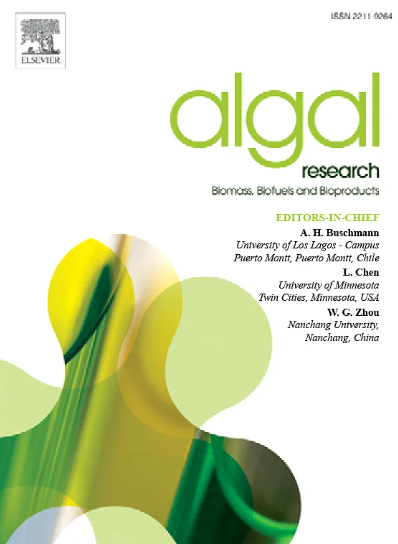Harnessing diatoms for sustainable economy: Integrating metabolic mechanism with wastewater treatment, biomass production and applications
IF 4.6
2区 生物学
Q1 BIOTECHNOLOGY & APPLIED MICROBIOLOGY
Algal Research-Biomass Biofuels and Bioproducts
Pub Date : 2025-04-08
DOI:10.1016/j.algal.2025.104031
引用次数: 0
Abstract
In the context of carbon neutrality, microalgae-based technologies are gaining recognition as a crucial pathway to sustainable development. Diatoms are a major group of eukaryotic algae that contribute significantly to global carbon fixation and exhibit strong adaptability to environmental stresses. Characterized by a silicified cell wall (frustule) and specialized metabolism, diatoms can be used to generate diverse biomass with high economic value. These attributes position them as promising candidates for the simultaneous application of wastewater bioremediation and biomass production. This review provides a comprehensive overview of diatom growth and metabolism, with a particular focus on mixotrophy and metabolic responses to environmental factors. Their potential for bioremediation in aquaculture and food industry wastewater is critically examined. Furthermore, the diverse applications of diatom biomass are explored, including its role in agricultural biofertilization and aquaculture feed supplementation with antimicrobial, disease-preventive, and growth-promoting properties. Notably, the silicified cell wall offers inherent advantages in cost-effectiveness and performance, making it a promising material for applications in catalysis, biosensors, and energy storage. Additionally, a feasibility analysis within the framework of the circular economy underscores the potential of diatoms in expanding the value chain and enhancing resource utilization efficiency. This review aims to deepen the understanding of diatom metabolic mechanisms to optimize cultivation strategies and provide comprehensive insights into diatom-mediated circular economic processes.

利用硅藻促进可持续经济:将代谢机制与废水处理、生物质生产和应用相结合
在碳中和的背景下,以微藻为基础的技术正逐渐被认为是实现可持续发展的关键途径。硅藻是一种重要的真核藻类,对全球碳固定有重要贡献,对环境胁迫具有很强的适应性。硅藻具有硅化的细胞壁和特殊的代谢特性,可用于生产具有高经济价值的多种生物质。这些特性使它们成为废水生物修复和生物质生产同时应用的有希望的候选者。本文综述了硅藻生长和代谢的全面概述,特别关注混合营养和对环境因素的代谢反应。它们在水产养殖和食品工业废水中的生物修复潜力进行了严格审查。此外,还探讨了硅藻生物质的多种应用,包括其在农业生物肥料和水产养殖饲料中具有抗菌、预防疾病和促进生长等特性的作用。值得注意的是,硅化细胞壁在成本效益和性能方面具有固有的优势,使其成为催化、生物传感器和能量存储方面应用的有前途的材料。此外,在循环经济框架内的可行性分析强调了硅藻在扩大价值链和提高资源利用效率方面的潜力。本文旨在加深对硅藻代谢机制的理解,以优化硅藻的培养策略,并为硅藻介导的循环经济过程提供全面的见解。
本文章由计算机程序翻译,如有差异,请以英文原文为准。
求助全文
约1分钟内获得全文
求助全文
来源期刊

Algal Research-Biomass Biofuels and Bioproducts
BIOTECHNOLOGY & APPLIED MICROBIOLOGY-
CiteScore
9.40
自引率
7.80%
发文量
332
期刊介绍:
Algal Research is an international phycology journal covering all areas of emerging technologies in algae biology, biomass production, cultivation, harvesting, extraction, bioproducts, biorefinery, engineering, and econometrics. Algae is defined to include cyanobacteria, microalgae, and protists and symbionts of interest in biotechnology. The journal publishes original research and reviews for the following scope: algal biology, including but not exclusive to: phylogeny, biodiversity, molecular traits, metabolic regulation, and genetic engineering, algal cultivation, e.g. phototrophic systems, heterotrophic systems, and mixotrophic systems, algal harvesting and extraction systems, biotechnology to convert algal biomass and components into biofuels and bioproducts, e.g., nutraceuticals, pharmaceuticals, animal feed, plastics, etc. algal products and their economic assessment
 求助内容:
求助内容: 应助结果提醒方式:
应助结果提醒方式:


